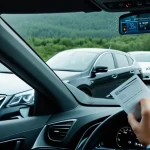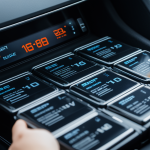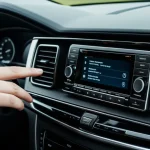Understanding Infotainment Systems
Navigating through the myriad options of infotainment systems can be a daunting task given their integral role in modern vehicles. These systems are essential car technology components, offering drivers a blend of information and entertainment. They typically feature navigation aids, music and audio streaming, and even internet access, all within a central display or touchscreen interface.
Overview of Infotainment Systems
At their core, infotainment systems integrate functions such as radio, satellite navigation, smartphone connectivity, and, increasingly, voice recognition. These features allow for seamless interaction with devices, enabling drivers to manage calls and messages hands-free, ensuring safer and more convenient driving.
Importance of Upgrading
Modern upgrades to your vehicle’s infotainment system can substantially enhance performance and safety. Advanced systems offer improved user interfaces, faster processing speeds, and enhanced graphics that make navigation and control impressive and intuitive. Upgrading ensures that your car stays current with technological advancements, ultimately boosting resale value and driving satisfaction.
Common Features Offered
Common features in newer infotainment systems include support for Apple CarPlay and Android Auto, enabling synchronization with mobile devices. Additionally, systems with built-in safety features such as reverse cameras and parking sensors contribute significantly to vehicle safety. By incorporating such features, modern infotainment units do more than entertain—they become pivotal tools for safer, more efficient driving.
In the same genre : Unlock Superior Performance: The Complete Guide to the Advantages of Synthetic Oil for High-Mileage Vehicles in the UK
Compliance with UK Road Regulations
Understanding UK road regulations concerning infotainment systems is crucial for legal compliance and road safety. The regulations primarily focus on ensuring that any upgrade or integration within a vehicle adheres to safety standards designed to minimise driver distraction. This includes ensuring that screen displays do not obstruct the driver’s view and are not overly bright or distracting.
Legal Requirements for Mobile Device Integration
When it comes to mobile device integration, UK law demands that drivers must maintain full control of their vehicle at all times. This means that hands-free setups such as Apple CarPlay and Android Auto are permissible, as they allow for voice control operation. However, using handheld devices while driving remains illegal and can lead to significant penalties, including fines and points added to your driving license.
Consequences of Non-Compliance
Failing to comply with UK road regulations regarding infotainment systems can result in severe repercussions. Beyond monetary fines and licensing points, non-compliance can lead to increased insurance premiums and legal liabilities in the case of an accident. Therefore, it is important to ensure that any enhancements or upgrades respect existing legal frameworks, promoting safer road usage and responsible driving behavior. Engaging qualified professionals to install and verify systems can further safeguard compliance and operational integrity.
Suitable Upgrades for Your Infotainment System
Investing in infotainment upgrades can transform your driving experience, blending convenience with enhanced safety. Modern vehicles now have versatile technological enhancements that cater to diverse driving needs, ensuring you stay connected and entertained.
Upgrading to Apple CarPlay and Android Auto
Apple CarPlay and Android Auto are becoming indispensable for seamless smartphone integration. They offer hands-free control, allowing drivers to access apps, make calls, and listen to music without distraction. These platforms are designed to mirror your smartphone interface on the car’s display. This integration ensures your mobile device functions are safely within reach, enhancing both convenience and compliance with regulations.
Adding Navigation Systems
High-quality navigation systems are a pivotal upgrade for any vehicle. They provide accurate real-time traffic updates, precise route guidance, and voice recognition features. By opting for advanced navigation systems, drivers benefit from efficient travel, reduced stress, and improved fuel consumption through optimal routing. These systems are a reliable co-pilot, ensuring you reach your destination with ease.
Enhancing Audio Systems
Revamping your car’s audio system can significantly enhance your in-car entertainment experience. Modern audio upgrades offer superior sound quality, with options for satellite radio and streaming services connectivity. By upgrading, you unlock a richer auditory experience, transforming every drive into a concert-like journey. It’s an upgrade worth considering for any music enthusiast aiming to improve their vehicle’s sound dynamics.
Step-by-Step Installation Instructions
Upgrading your infotainment system can significantly enhance your car technology experience, blending modern upgrades with functionality. Whether you’re adding new safety features or integrating advanced navigation systems, following a DIY upgrade approach requires careful attention to technical instructions and safety precautions.
Essential Tools and Equipment
Before diving into the installation, gather the essential tools and equipment. Basic items you’ll need include:
- Screwdrivers (Phillips and flathead)
- Wire strippers and crimpers
- Trim panel removal tools
- Multimeter for electrical testing
Ensure you have the right mounting brackets and harness adapters compatible with your vehicle’s specifications.
Step-by-Step Guide for Installation
-
Disconnect the Battery: Always start by disconnecting the vehicle’s negative battery terminal to prevent electrical hazards.
-
Remove Existing Unit: Use trim panel removal tools to carefully detach panels. Unscrew and remove the existing infotainment unit.
-
Install New Components: Connect wiring harnesses to the new system, securing them tightly. Follow the manufacturer’s instructions for accurate connections, particular care should be taken with safety features like reverse cameras.
-
Test the System: Before reassembling, reconnect the battery and test all functionalities such as audio, navigation, and smartphone integration. Use a multimeter to ensure all electrical connections are stable.
-
Reassemble: Once confirmed everything works, reattach panels and screws. Double-check all components are securely in place.
Safety Precautions
- Always work in a well-lit, clutter-free environment to avoid mistakes.
- Be mindful of sharp tools and loose wires which could pose injury if not handled properly.
- Consider professional assistance if you are unsure during any step of the installation process.
Adhering to these steps not only ensures a successful upgrade but also enhances your driving experience with improved technology and compliance with safety standards.
Safety Tips for Use
Navigating infotainment systems while driving can enhance your journey but also demands attention to safety. Prioritising safe driving is imperative to utilise these systems responsibly.
Best Practices for Using Infotainment Systems
-
Minimise On-Screen Interaction: Limit screen touches by using voice commands or steering wheel controls where possible. This helps maintain focus on the road.
-
Plan Before Moving: Set your navigation and entertainment preferences before you start driving. Changing settings on the move can lead to distractions.
-
Keep the Display at Eye Level: Ensure the display is properly aligned within your line of sight. This reduces the need for excessive eye movement away from the road.
Importance of Distraction-Free Driving
Maintaining hands-free interaction is vital. Studies show that even brief distraction can significantly increase accident risk. Systems like Apple CarPlay and Android Auto are designed for minimal disruption, using voice control to manage calls and messages without diverting attention.
Recommendations for Safer Driving Features
- Park Assist Cameras: These provide visual cues for easier parking, reducing stress and improving safety.
- Adaptive Cruise Control: Adjusts speed automatically, allowing for smoother traffic navigation.
- Lane Departure Warnings: Alert you if the vehicle drifts, encouraging lane discipline and road safety.
Instilling these habits and leveraging smart car technology can make every journey safer and more enjoyable.
Product Recommendations
Choosing the right infotainment system significantly enhances your driving experience by combining convenience, functionality, and safety. Let’s explore some top products on the market.
Popular Infotainment Systems
Several brands have become synonymous with high-quality car technology. These systems offer modern upgrades that are essential for today’s drivers. Pioneer, Alpine, and Sony are renowned for their robust offerings, boasting features such as Apple CarPlay and Android Auto compatibility, high-resolution displays, and intuitive controls.
Expert Opinions
Experts often recommend Pioneer AVH-W4400NEX or Alpine iLX-W650 for their dependability and range of capabilities. These systems are celebrated for seamless integration with smartphones, which is essential for staying connected on the road. They also provide superior audio quality and responsive touchscreen interfaces.
User Testimonials
Real-world experiences from users highlight the value of investing in a modern infotainment system. Many commend the clarity of navigation features and ease of use while driving. Users often praise the reduction in driver distraction, thanks to sophisticated voice control functionalities. Investing in a quality system aligned with your needs enhances driving enjoyment and safety.
Ensuring Compatibility with Your Vehicle
When considering infotainment upgrades, ensuring vehicle compatibility is paramount. This step is essential to avoid mismatches that could hinder system performance or even cause damage to your vehicle. Here’s how to verify compatibility and what to look out for.
Verifying Compatibility
Begin by reviewing your vehicle’s specifications in the owner’s manual or on the manufacturer’s website. This will provide vital information on the system’s capabilities and any limitations regarding upgrades. Confirming compatibility ensures that the new system will integrate seamlessly with existing features and harnesses.
Consulting Manufacturer Guidelines
Each automobile brand may have unique specifications or instructions regarding infotainment system replacements or upgrades. Refer to these guidelines to identify approved components and installation processes, reducing the risk of voiding warranties. Companies often provide a list of compatible systems which can be invaluable when selecting an upgrade.
Potential Issues
Mismatched components can lead to a range of potential issues, from electrical faults to impaired functionality of safety features. For example, failing to align the system properly with the vehicle’s wiring harness can disrupt power supply and connectivity. To mitigate these risks, ensure that adapters and connectors are specifically designed for your vehicle model. Consider professional installation if uncertainty arises.
Tips for a Smooth Integration
- Check compatibility: Use online tools or apps that match car models with compatible infotainment systems.
- Consult professionals: Seek advice from certified auto technicians to confirm your choices.
- Test equipment: Prior to permanent installation, temporarily set up the system to ensure full functionality.
By taking the time to verify these aspects, you ensure a smooth upgrade process, enhancing your driving experience without compromising safety or vehicle performance.
Accessing Relevant Regulations and Resources
Navigating the intricate UK road regulations regarding infotainment systems is pivotal to ensure compliance and enhance safety. Here’s how to easily access guidelines and crucial information that govern these technological upgrades.
Overview of Available Resources
Numerous resources exist to help car owners stay informed about infotainment upgrades and related legal requirements. The UK government’s official website provides comprehensive information on road safety guidelines and legal standards. Automotive industry bodies also offer insightful reports on best practices for safe driving and technological compliance. These resources are invaluable for making informed decisions on modernizing your vehicle’s car technology.
Finding Regulatory Links
Accessing correct regulatory links ensures your infotainment systems align with the latest UK road regulations. Start with official UK government sites, which frequently update their web pages to reflect changes in technology regulations. Trade associations and consumer automotive organizations also curate resourceful sections with downloadable content, summarizing legal requirements for infotainment setups.
Recommendations for Further Reading and Professional Advice
Engage with professional advice for expert insights and clarity on UK road regulations. Certified automotive technicians often publish articles and guides through various platforms detailing the nuances of infotainment system upgrades. Furthermore, consider automotive forums and review sites for community-driven discussions. These platforms can offer real-world insights and experiences from fellow car enthusiasts who have navigated regulatory landscapes.
By utilizing these resources, car owners can confidently proceed with upgrades, ensuring all safety measures and legal obligations are met.








